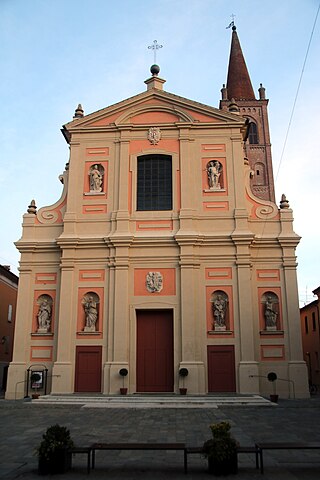
Lake Lugano is a glacial lake which is situated on the border between southern Switzerland and northern Italy. The lake, named after the city of Lugano, is situated between Lake Como and Lago Maggiore. It was cited for the first time by Gregory of Tours in 590 with the name Ceresio, a name which is said to have derived from the Latin word cerasus, meaning cherry, and refers to the abundance of cherry trees which at one time adorned the shores of the lake. The lake appears in documents in 804 under the name Laco Luanasco.

Arnolfo di Cambio was an Italian architect and sculptor of the Duecento, who began as a lead assistant to Nicola Pisano. He is documented as being capomaestro or Head of Works for Florence Cathedral in 1300, and designed the sixth city wall around Florence (1284–1333).

San Marco is one of the six sestieri of Venice, lying in the heart of the city as the main place of Venice. San Marco also includes the island of San Giorgio Maggiore. Although the district includes Saint Mark's Square, that was never administered as part of the sestiere.

San Giorgio Maggiore is one of the islands of Venice, northern Italy, lying east of the Giudecca and south of the main island group. The island, or more specifically its Palladian church, is an important landmark. It has been much painted, featuring for example in a series by Monet.
San Giorgio, is the Italian form of Saint George. When used as the name of a person it is frequently contracted to Sangiorgio.

Pellegrino Tibaldi, also known as Pellegrino di Tibaldo de Pellegrini, was an Italian mannerist architect, sculptor, and mural painter.

Lorenzo Sabbatini or Sabatini, Sabattini or Sabadini, sometimes referred to as Lorenzino da Bologna, was an Italian painter of the Mannerist period from Bologna.

Saint-Georges majeur au crépuscule refers to an Impressionist painting by Claude Monet, which exists in more than one version. It forms part of a series of views of the monastery-island of San Giorgio Maggiore. This series is in turn part of a larger series of views of Venice which Monet began in 1908 during his only visit there.

Santa Maria Maggiore di Firenze is a Romanesque and Gothic-style, Roman Catholic church in Florence, region of Tuscany, Italy. This is among the oldest extant churches in Florence.

Pieve di Cento is a comune (municipality) in the Metropolitan City of Bologna in the Italian region Emilia-Romagna, located about 25 kilometres (16 mi) north of Bologna.

The San Giorgio Monastery is a Benedictine monastery in Venice, Italy, located on the island of San Giorgio Maggiore. It stands next to the Church of San Giorgio Maggiore, which serves the monastic community. Most of the old monastic buildings currently serve as headquarters of the Cini Foundation.

San Giorgio Maggiore is a 16th-century Benedictine church on the island of the same name in Venice, northern Italy, designed by Andrea Palladio, and built between 1566 and 1610. The church is a basilica in the classical Renaissance style and its brilliant white marble gleams above the blue water of the lagoon opposite the Piazzetta di San Marco and forms the focal point of the view from every part of the Riva degli Schiavoni.

San Francesco alle Scale is a church in Ancona, central Italy.
The Blessed John Morosini, O.S.B., was a Venetian abbot, who founded the noted Monastery of St. George in that city.
The bailo and captain of Negroponte was the representative of the Republic of Venice stationed at Chalcis (Negroponte) on the island of Euboea. The bailo played an important role as the mediator between, and de facto overlord of, the triarchs of Euboea, who had their common residence in Negroponte. The triarchies were created by the division of the island between three rulers (triarchs) after its conquest following the Fourth Crusade (1204).

The Doge's Palace Seen from San Giorgio Maggiore is a 1908 painting by Claude Monet that resides in the collection of the Metropolitan Museum of Art. The painting, catalogued W1755 in the Wildenstein catalogue raisonné, is one of a series of six versions of this scene painted by Monet in 1908. Other versions are held by the Kunsthaus Zürich and the Solomon R. Guggenheim Museum.

Claude Monet painted a series of paintings of the island-monastery of San Giorgio Maggiore in Venice. They were begun in 1908 during the artist's only visit to the city. One of the best known is San Giorgio Maggiore at Dusk, which exists in two versions.

The Portrait of Doge Leonardo Loredan is a painting by the Italian Renaissance master Vittore Carpaccio, a painter of the Venetian School and student of Gentile Bellini. The latter also painted a portrait of Doge Leonardo Loredan. It was most likely painted around 1501/02, at the beginning of Loredan's reign. The painting was restored in 2003 with funding from Mara and Chuck Robinson in honour of Prof. W. R. Rearick, and it is now displayed in the Museo Correr in Venice.
San Giorgio Maggiore is one of the islands of Venice, Italy.















